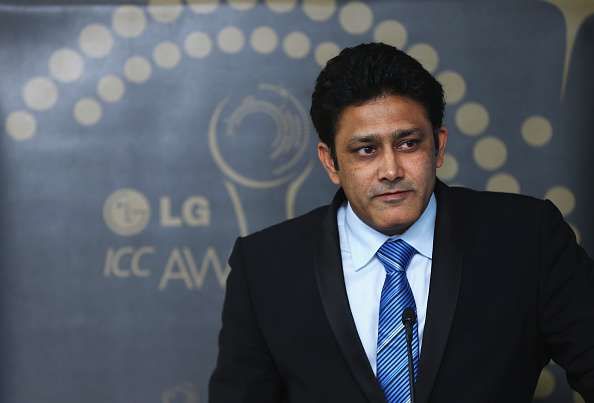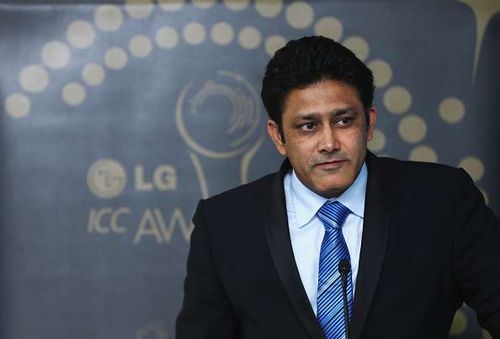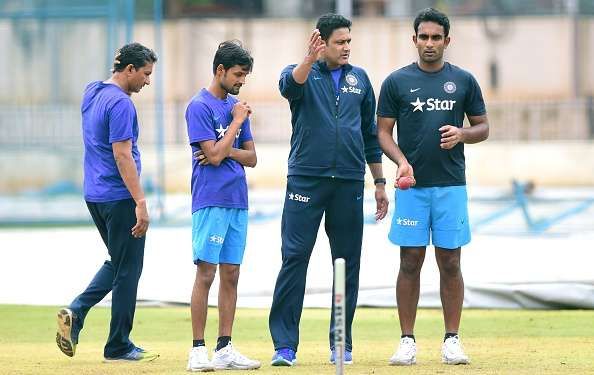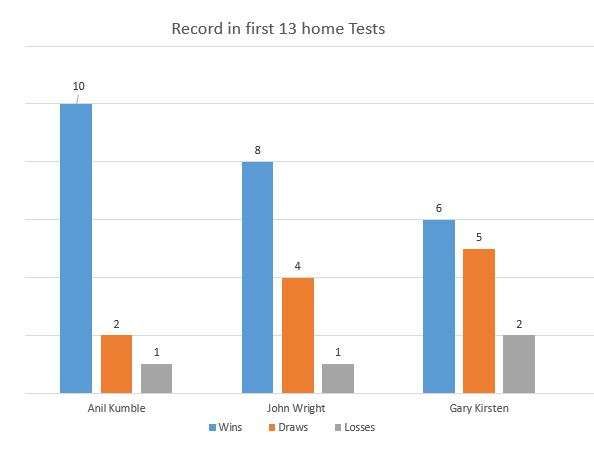
The fault in our stars, and the legacy of India's 363-day coach
“You either die a hero, or live long enough to see yourself become the villain.”
One of my biggest pursuits has been to find a person whose life doesn’t fit this quote from The Dark Knight. I was always disappointed in my search as I could never come across such an individual.
Now, though, I have finally witnessed something that cannot be defined by the words, and I almost wish I hadn’t.
Following a month full of reports speculating Anil Kumble’s future with the Indian cricket team and his alleged feud with captain Virat Kohli, the man has decided to step down as the head coach after the expiry of his BCCI contract. Let us look at the timeline of his coaching stint:
| Appointed as head coach | June 22, 2016 |
| India’s tour of West Indies | 2 Tests (won 2-0), 1 T20I (lost 0-1) |
| New Zealand’s tour of India | 3 Tests (won 3-0), 5 ODIs (won 3-2) |
| England’s tour of India | 5 Tests (won 4-0), 3 ODIs (won 2-1), 3 T20I (won 2-1) |
| Bangladesh one-off Test | Won (1-0) |
| Australia’s tour of India | 4 Tests (won 2-1) |
| ICC Champions Trophy 2017 | Runners-up, 5 ODIs (3-2) |
| Resigned as head coach | June 20, 2017 |
| Test series won | 5 out of 5 |
| ODI series won | 2 out of 3 |
| T20I series won | 1 out of 2 |
| Tenure | 363 days |
These are numbers any coach in any part of the world would grab at the drop of a hat. Kumble was a part of the Indian dressing room for 15 Test matches, and the team won 12 of them. The only real hiccup that they faced within this period was when they lost a single Test to Australia in Pune. The team had remained unbeaten in eight consecutive home Tests before that.
Also read: Twitter reacts to Kumble’s resignation
Let us look at Kumble’s coaching legacy beyond these numbers:
Grooming Indian players
Reports about the Indian players being uncomfortable under the ‘strict regimen’ and discipline of Kumble were making the rounds before the ICC Champions Trophy 2017. It was believed that the man from Bangalore had created a rigid and inflexible environment around the team, which formed a fissure between him and the players.
“My partnership with Kumble is a match made in heaven,” said Ravi Ashwin after his astounding success against New Zealand last year. The off-spinner ended the home season with 80 wickets to his name, breaking Dale Steyn’s record on the way.
Ravindra Jadeja, Ashwin’s partner in crime, credited Kumble for his consistent domination of Kane Williamson. “Footmarks will always have an effect on the batsman’s mind” was what Kumble had told Jadeja, and that’s what the left-arm spinner took full advantage of.
Jadeja is now the top-ranked bowler in Test cricket.
Kumble also turned into a left-arm spinner to help Cheteshwar Pujara with his technique after Steve O’ Keefe had wreaked havoc in the India-Australia Test in Pune. India’s reliable number 3 scored a match-winning 92 at the Chinnaswamy Stadium in the very next match, followed by his third double-hundred at Ranchi.
When KL Rahul got out for an unfortunate score of 199 in the fifth Test against England, the youngster was visibly frustrated and disappointed. When asked about how he overcame missing out on the double-century, the then 24-year-old said that Kumble and Sanjay Bangar told him that getting out for 199 was actually a good thing: it would spur him on to get 200 in his next innings. The Indian opener ended up scoring six half-centuries in his next nine innings after the pep talk.
Ajinkya Rahane wasn’t overlooked during his injury crisis and made an instant comeback into the team after being declared fit, taking the place of a batsman who had recently scored a mind-numbing triple-century, Karun Nair. “We remember what Rahane has done,” Kumble retorted, when questioned about his inclusion.
Players like Nair, Jayant Yadav, Kedar Jadhav and of course, Kuldeep Yadav made their debuts during Kumble’s tenure. All of them fared exceedingly well, with each player etching a unique and unforgettable record next to his name.
India’s bowling unit, which was always considered their weaker sphere, started sending experienced batting orders into tailspins. While the Ashwin-Jadeja partnership was an unsolvable mystery, each and every fast bowler came into his own in different phases of the season.
The players truly suffered under Kumble’s headmastership, didn’t they?
Also read: Five biggest Indian wins under Kumble’s
Comparison with other successful Indian coaches
John Wright and Gary Kirsten are probably the two names that best fit India’s definition of a ‘perfect coach’. They remained on the sidelines, built a long-lasting camaraderie with the captain and conjured magical results on the field.
Wright was the man responsible for building a team with Sachin Tendulkar, Rahul Dravid, Sourav Ganguly, Anil Kumble, VVS Laxman and Virender Sehwag: we just have to love him, don’t we? His coaching tenure included India’s record-creating series victory against Australia, an ICC World Cup final and several other Test accolades.
The man put an end to the ritual of players eating chai-biscuit before practice sessions, and Wright was quite the disciplinarian. “Rules applied for everyone (on the team), from the graduates to the drop-outs,” he once said.
Kirsten, the say-little work-more man from South Africa, is undoubtedly the most lovable coach in cricketing history. He preferred to stay away from the limelight and get the job done quietly. He was in charge of a team in transition but managed to win the World Cup with them. When India crashed out of the ICC WT20 2010, Kirsten declared that the team lacked ‘fitness’ and ‘discipline.’ In a move that irked many players, he ended up setting a curfew of 9.30 pm for the team, especially when India had a morning match the next day.
Kumble, meanwhile, who was chosen to be the head coach of the team ahead of the team director Ravi Shastri, has better first-year results than both these coaches. His team not only claimed the No. 1 Test ranking in the world but also created a record for the maximum number of matches won in a home season. Kumble, who is known for his fiery temper, tried to instil structure into the Indian team’s proceedings, just as his predecessors did.
His results? Exceptional. His methods? Proven. His popularity? Questionable.
Also read: You don’t want a yes-man as your coach, says Jason Gillespie
Conclusion
The players are undoubtedly the most important components in any sport. Their wingmen, though forgotten most of the times, are just as crucial to their success.
In his autobiography, Andre Agassi said that he would take his racquet stringer to London, Paris and Melbourne when he played in Wimbledon, Roland Garros and the Australian Open, knowing that no one would be able to do a job like him.
Sachin Tendulkar would not have been Sachin Tendulkar today had his trusted entourage of medical professionals not stood by him throughout his career. Whenever a football team underperforms in a league season, the players might be responsible, but it's their manager who bears the brunt.
Coaches, trainers and physios travel everywhere with the team, and consistently ensure that the players perform at their peak. The credit at the end of it all goes to the players, and rightly so.
The players might not be comfortable with an individual and they have to have a say in his appointment. However, can they have the only say? Is bad blood between two camps enough to oust a person from the team? If a player falls into the same trap tomorrow, what will the course of action be, provided his recent performances have been off the charts? Questions like these are worth pondering, even when their answers remain unambiguous.
When I read about Kumble’s resignation yesterday, a memory popped into my head: tired of being picked on for my bad grades, I ran to complain to my mother as a 6-year-old. I felt that the world could not have been more unfair. My mother smiled down at me. “Do your job, dear. Do your job well, and then no one would be able to bully you,” she said.
I wonder what she has to say now.


